Abstract
In the article the principles of region economic security formation are examined and a pyramid of modules of economic security of the region is built. This pyramid allows to calculate the risk indicators of reducing the economic security level of a region through a matrix of elasticity coefficients. Nowadays, the assessment of the risk factors impact of the economic security of the Chechen Republic has been partly studied. From the point of view of evaluation and analysis of the indicator of compliance with the economic security principles, a summary table was formed without highlighting the degree of significance of each characteristic determined by the influence degree of factors. A differentiated approach to the indicators, entering generalizing, production and resource and indicative social factors were developed and the indicators of the republic’s economic security were analyzed using a matrix of elasticity parameters. The zones of risk and loss of region economic security are identified, and their types are highlighted. Based on the calculated elasticity coefficients obtained for each of the indicators in relation to the identified key factors in each subgroup, calculations are performed. They allow to determine the key risk factors and their types in a ranked section. The authors also have a mechanism and a way to create tactical and analytical groups to develop solution options, programs and projects for leveling the risks of threats and neutralizing them, as well as control and expert groups performing a regulatory and regulatory function.
Keywords: Economic securityregionstabilityimprovementthreat
Introduction
In the conditions of Russia’s transition to an innovative development path, risks of ensuring economic security have significantly increased. Risk factors of the state’s economic security, and as a result, risks of reducing the level of the economic security of the Chechen Republic during the sanctions period have been actualized. Also considering the socio-political, socio-economic and ethno-cultural situation in the North Caucasus, contributing to the escalation of economic risks and threats, causes the creation of a full-fledged immunity of the economic sphere with the introduction of international sanctions against Russia and its residents (individuals and legal entities).
Problem Statement
In the post-war period, the high growth and recovery rates of the socio-economics situation in the Chechen Republic show the positive demographic dynamics and socio-political processes for consolidating the population stabilizing. In addition, they allow to observe the permanent growing social differentiation, the low (Tsakayev, 2011a) level and quality of life, the rise in prices for goods and services, the high level of food, the agricultural and financial dependence (Tsakaev, 2011b), as well as unregistered economic incomes, which generate high volatility of socio-economic characteristics and threats to the economic security of the region.
Research Questions
The study of economic security in the Chechen Republic, especially the analysis of threats, has not yet been fully studied from the point of view of studying the reducing economic security of public legal entities. Nowadays there is no legally established list of key indicators and indicators of economic security, which allowed for an objective assessment of the socio-economic status. Besides key risks and economic security threats were not formulated. The approved state strategic documents for ensuring the economic security need rational improvements, new mechanisms aimed at regional and national threats to the real sector of the economy. Everything was the basis for considering the problem of the economic security of public law entities from the standpoint of assessing, analyzing and developing effective preventive measures to identify the threat risk to the economic security of the Chechen Republic.
Purpose of the Study
The purpose of this study is to assess the level of economic security in the region and to improve the mechanism for managing economic security using the example of the Chechen Republic.
Research Methods
Analyzed the concepts of “economic security” and its methodological basis in the context of national economic security, the following components should be distinguished: the characteristics defining the goal, the directions of achieving the goal and the state regulation leading to the achievement of the desired results. In addition, in the formation of any category, there are limiting factors that close the category within the framework of the studied issue and the factors with a regulatory function.
In the interpretations of economic security, there are characteristics of the state almost in all its manifestations: stability, development and improvement. These actions and states should correspond to the interests formulated by the research unit (Tsakayev & Khadisov, 2017). Independence in its various directions predominantly serves as the key goal.
As risk factors, external and internal factors are predominantly denoted. They realize the regulatory function, independence, for which a regulatory function is introduced as a factor in counteracting these threats (Figure
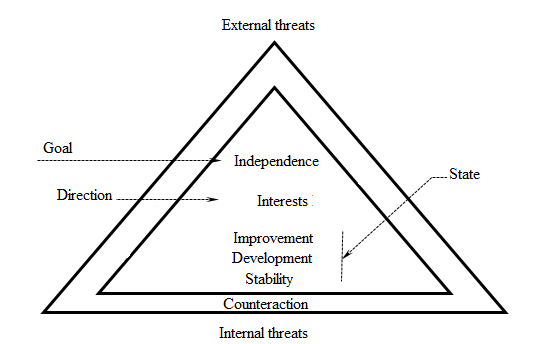
Having considered the factors as indicators of risk assessment of a decrease in economic security, as well as indicators of sustainability and other factors causing static and dynamic processes occurring in the region, a common trend can be defined (Tsakayev & Khadisov, 2017). For the formation of estimated characteristics, it is not enough to choose a list of indicators if they do not meet the methodological rules. As a result, it is necessary to distinguish 3 main projections of the formation of indicator blocks:
1. Dynamic and structural changes and ratios;
2. Unity of the transaction unit;
3. Vector.
Primarily, the main characteristic of the indicator, which determines the economic security of the region, must relate to one or another basic indicator in order to gain economic interpretation. The transaction unit makes the gradation along the plane of factors intensive interaction. In the primary, non-detailed groups (Khadisov, 2017), this systematization is classified into financial, resource and social systems. Thirdly, the vector approach to the formation of indicators completes the set of actions to identify the functional and purpose. Directions in this case are divided into external, internal and regulatory.
After analyzing the indicators for assessing the risk of reducing the level of economic security presented in the works of domestic economists S. Yu. Glaz’yeva, A. Illarionova, G.G. Balabanova, N.S. Kozyr’, A.V. Getmanova (Khadisov, 2016; Tsakayev & Khadisov, 2017; Tsakayev, 2011a; Glazyev, 2016; Kaziakhmedov & Bagmet, 2015; Bogdanov, 2011; Yandyganov, Vlasova, & Nikulina, 2008), they reflect on the elemental characteristics and assessment objectives (Figure
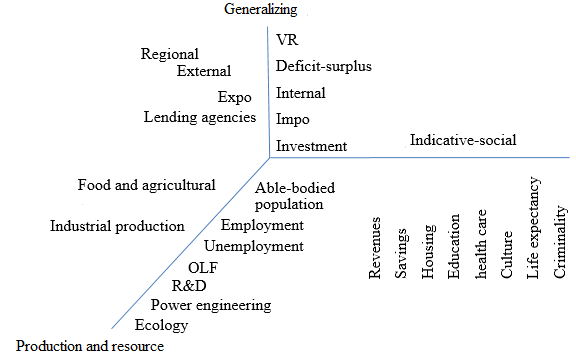
The indicated indicators can be divided into 3 main areas according to their meaning and reflection of information: resumptive, production-resource and indicative-social.
Resumptive indicators include gross regional product, state of regional debt, import and export: they reflect key trends and describe the situation. However, they cannot describe a causal relationship and objectively establish the causes. On this basis, these factors can only be considered in connection with others, which levels the negative aspects of their formation.
The last direction of the indicators is indicative-social. On the one hand, they do not directly act as a factor of influence, but, on the other hand, they reflect the result of the effective functioning of the region and compensate for the distortions causing risk-generating economic factors. Improvement should be considered only in comparison in the dynamics of similar indicators both in the region and in the Russian Federation. It is not possible to assess compliance with this indicator in the system of mono indicators, since the regional economy generates a complex of interrelated elements.
For a more detailed review of the assessment and analysis of dynamic changes in the functioning of the region (Tsakayev & Khadisov, 2017) we take the data of the Federal State Statistics Service for the period from 2005 to 2015. For a dynamic and economic analysis of a region, the time series contains 11 points that characterize an expanded range of tools and statistical modeling methods for estimation, resulting changes and correlations. As previously described, an information interval up to 2000 cannot be set. Since 2000 until 2005, there have been actual socio-economic changes of a spontaneous and non-systemic nature, which makes their quantitative assessments not subject to prediction and analysis in terms of both established trends and the fundamentals of methodological changes in terms of methods for collecting and formulating the result.
As an assessment of the risk factor of compliance with the principles of economic security, the results should be analyzed without considering the importance degree of individual factors. Because of a high probability of the influence degree on the calculations within the framework of an integrated assessment and analysis of the results obtained, it is necessary to take a threefold assessment system: “–1” – non-compliance, “0” – partial compliance, “1” – compliance (Tsakayev & Khadisov, 2017).
- Stability –- a dynamic variability of the indicator;
- Development – a direction of dynamic change;
- Improvement – a change in the share in the total sample;
- Independence – a stochastic analysis of the relationship.
Now the obtained data should be summarized in a matrix for the previously described risk parameters for reducing the level of economic security. This table was compiled with the assumption that the level of influence of each factor and its intensity are equal in importance with respect to characterizing values of economic security.
The distribution of the actual points of the region indicators to a greater extent in the instability zone accounts for 48% of the sample. The second place is occupied by points in the zone of stability - 46%. Such a gradation suggests that the object of study appears to be stable with a significant proportion of unstable risk factors that characterize a significant role in the reducing the level of region economic security.
The results allow to consider this trend in a factor way, in the previously obtained values. The main disadvantage and typical problem in a dynamic analysis is the impossibility of considering the indicator development when receiving information. To achieve this goal, the transformational BCG-matrix is be used, where X is the average value according to the criteria of “sustainability” and “development”, and along the Y axis is the average value according to the criteria of “improvement”, “independence”. Thereby we get the value for 2017 (0.5; 0.37).
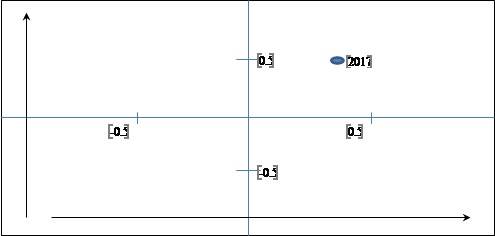
According to the chart it can be argued that the Chechen Republic in its selected indicators is an intensively and dynamically developing region with a steady direction of achievement in key factors of stability and independence. It is important to note that these generalizations are significant in the initial calculation. For a more specific description, in the context of this study, it is necessary to determine the influence strength of each system indicator for assessing and analyzing threats to the region economic security.
The main risk factors relate to the exacerbation of the existing “weaknesses”. The problem points of the instability zone of the Chechen Republic are related, on the one hand, to socio-economic factors, on the other, foreign policy and criminal factors that complement each other and reinforce the common (Tsakayev & Khadisov, 2017) destructive impact.
To achieve the goal and the objectives it is important to determine the strength and degree of risk factors influence. For this, it is necessary to use the results of single-factor regression equations.
Single-factor regression equations are taken because of objective processes, as well as ща lack of alternative in the available statistical data. There are 11 points in the dynamic range, and a larger number to build in this region does not seem realistic due to the hostilities, the fragmentation of the initial information in previous periods and the existing high variability.
In the single-factor model, the coefficient of the model bi should be considered, since this coefficient is an objective characteristic when determining the influence strength. However, for integral evaluation and data analysis, the coefficients bi of the entire system of paired equations are not comparable. Thus, we normalize them by calculating the coefficient of elasticity
The
The weaker influence is expressed in terms of life expectancy, agricultural production and the number of economically active population. For agricultural production and longevity, the size is due to the substantial size of negative values, as well as the low proportion of the employment rates. These results are a signaling prerequisite and should be the object of special attention. However, we should drop out of it, since the purpose of the study and analysis is to identify general trends and variations in the fluctuations of elasticity coefficients and national trends.
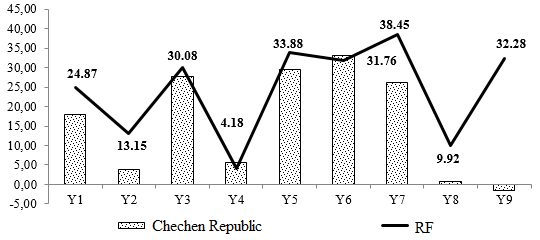
According the above data, the key risk areas are:
- demographic factors and age aspects in the vector of aging;
- production factors causing a high dependence on external factors (Khadisov, 2016) and the aging of legal status, as a result of which there is a high social sensitivity to transformations in them;
- priority on external (imported) R & D development.
Depending on the factors causing the risks, an effective solution, aimed at identifying the nature of the polarity reversal, or at eliminating asynchrony, or at determining the strength and degree of influence, must be found for each generating risk.
In terms of modality, life expectancy takes the leading position in extreme values.
The following, by the number of identified risks in the block of resumptive indicators: revenues; in production and resource: agricultural production, costs of research and development, population, number of employed people; in terms of indicative social: fertility rate and graduation rates. ( Table
The latter group is less numerous and consists of generalizing indicators: Gross Regional Pbroduct and the state of the regional budget. In general, they can be defined as indicators of the economic activity of the region. Particular attention should be paid to the number of unemployed persons and the capital consumption (Khadisov, 2016; Tsakayev & Khadisov, 2017). The number of unemployed persons is a duplicate one characterized by a turn-out of specialists and a workforce. That is why this problem should be attributed to the previous risk group. The capital consumption is related to the factors of agricultural production and income. This characterizes the increased significance of the factor due to its structural elements and links to previously obtained indicators.
For more rapid and effective provision of regional economic security, a special body is needed through which to coordinate the activities of the executive bodies.
For effective implement of the risk management mechanism to reduce the level of economic security in the region it is necessary to improve the economic security of the region (Figure 06). A monitoring of the economic security should examine the deviations from the expected parameters of risk factors for reducing the level of economic security, the process of generating preventive risk localization measures and a quantitative and qualitative assessment of the effectiveness of these risks. The method of evaluation has been studied in detail in several works (Tsakayev, 2011b, Tatarkin, Kuklin, Vasil’yeva, & Nikulina, 2012; Amosov, 2017; Tolkachev, 2014; Kostrova & Minat, 2014; Sukhovey & Golova, 2016; Lenchuk, 2016).
The final stage of all stages is the transfer of analytical notes to the Government of the Chechen Republic:
- about detected threats of reducing the level of economic security and about the reasons for their occurrence;
- on the adoption of operational measures to localize the risk of economic security.
Further, it should be guided by the definition of zones of risk factors and threats to the economic security of the region with the determination of degree, impact level and associated factors. Based on the detected destructive factors, a creating of commission follows in order to avoid abuse and distortions. The first step in the formation of a general expert population is based on a rating selection and the following features:
1. Achievements in practical activities;
2. Achievements in academic knowledge.
Then an aim is set forth for the target group. According to the goal, the tactical-analytical group determines the structure of the tasks. The tactics and strategy of actions, as well as the methods and mechanisms of implementation are created by the group itself. Further, the responsibility for the implementation of this program is distributed, then it is assigned to the rank of a subject, and after the task is completed, the group should be dissolved.
At this stage, there is also an element of fixing the level and quality of work performed, the assessment of the control group should be carried out by comparing the results of expert supervisors in comparison with the results calculated through the mechanisms of comparative analysis.
In order to avoid misunderstandings in powers and obligations, a memorandum should be developed. It should be signed by both the representatives of the tactical and analytical group and the expert supervisors.
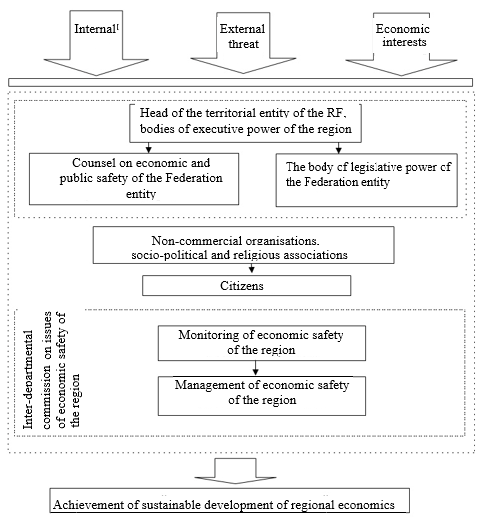
The participants of the groups sign a contract as a regulatory key document, on which relations between the participants of the groups are written. According to its structure, it is necessary to designate the size and type of financing, rights, responsibilities and obligations. Violations and non-compliance with the contract are fixed, and the settlement is implemented in accordance with the legislation of the Russian Federation.
Findings
The results of this study can be indicated by the following positions:
the principles of region economic security and the construction of a pyramid of the region economic security modules were investigated;
criteria for approaching the assessing sources of the region economic security threat are scientifically substantiated;
a system for analyzing and evaluating the calculation of changes in risk-forming factors is developed in the system of region economic security;
a mechanism was built for assessing threat indicators using elasticity coefficients;
a mechanism for creating tactical-analytical, as well as control and expert groups to reduce threats has been formulated.
Conclusion
In conclusion, it is worth summarizing the main scientific results and conclusions:
1. The methods of both modern Western and domestic economic scientists to assess the factors and problems of economic security are analyzed. The system of economic security indicators of the Chechen Republic was developed. The use of this system makes it possible to more objectively identify risk in the economy of the Chechen Republic. The proposed methodology allows to set the parameters to the greatest and least relevant to the desired requirements.
2. The differentiated analysis approach has been developed for factors: resumptive, production-resource, and indicative-social. This approach is based on the calculated indicators of elasticity coefficients obtained for individual elements in comparison with the selected main parameters of the subgroups. The results, which allow to determine the key risk segments in a ranked form, as well as their types, are calculated. This model made it possible to consider both the degree of significance and the power of influence, especially its intensity separately from the factors, and to obtain an integral value. The completion of this calculation was a hierarchical list of zones of special attention in descending order.
3. The analysis shows that the economic security of the Chechen Republic is influenced by serious risk factors. In order to make the most efficient use of available resources, it is necessary to identify key factors from many problems and concentrate efforts on their solution. It should be noted that the potential for positive scenario development in the region is much higher than the negative scenario. The main risk-forming factors in ensuring the economic security of the Chechen Republic are associated with the strengthening of the existing “weaknesses”. The weaknesses of the region are associated with both socio-economic and foreign policy, criminal risk factors, which complement each other and increase the overall negative impact.
4. A mechanism and method of creating tactical and analytical groups has been developed to draw up solutions and develop programs for leveling the risks of threats and neutralizing them, as well as control and expert groups carrying out the regulatory function. This mechanism must create regional programs for the sustainable development of the economy and minimize the influence of destructive factors.
Acknowledgments
The authors are deeply grateful to Professor Tsakayev Alkhozur Kharonovich for their assistance in carrying out this study and the continued interest in the work, as well as to the reviewers for valuable comments.
References
- Amosov, A. (2017). The goals of economic restructuring. Economist, 7, 14-25.
- Bogdanov, I. Ya. (2011). Russia’s economic security. Theory and practice, 1, p. 216.
- Glazyev, S. (2016). Economy of the future. Does Russia have a chance? Moscow: Knizhnyy mir.
- Kaziakhmedov, G. M., Bagmet, A. M. (2015). Problems of crime in economics. Vestnik ekonomicheskoy bezopasnosti - Economic Security Bulletin, 5, 54-56.
- Khadisov, M.-R.B. (2016). The state of the economic security of the Chechen Republic: problems and solutions. National Interests: Priorities and Security, 3, 137-150.
- Kostrova, Yu. B., Minat, V. N. (2014). Regional economic security and anti-corruption policy: assessment, management, improvement. Monograph. Ryazan: Kontseptsiya.
- Lenchuk, E. B. (2016). The course for new industrialization. A global trend of economic development. Forecasting problems, 3, 132-143.
- Sukhovey, A. F., Golova, I. M. (2016). Justification of the transformation priorities of innovation and technological development of the Russian Federation’s regions in the context of the global crisis. Economy of the region, 12, 3, 911-923.
- Tatarkin, A. I., Kuklin, A. A., Vasil’yeva, E. V., Nikulina, N. L. (2012). Quality of life as a system dominant of increasing the economic security of the region. Bulletin of Tyumen State University, 11, 38-49.
- Tolkachev, S. (2014). Reindustrialization in the United States. The eve of the neo-industrial lifestyle. Economist, 10, 54-69.
- Tsakayev, A.Kh. (2011a) Economic efficiency of risk management: indicators and criteria. Marketing in Russia and abroad, 2, 8-17.
- Tsakayev, A. Kh. (2011b). Cost-effectiveness of risk management: methodological aspects of assessment. Risk management, 2, 24-29.
- Tsakayev, A. Kh., Khadisov, M.-R.B. (2017). Assessment and analysis of the risk of reducing the level of economic security in the region: tools and indicators. Risk Management, 3 (83), 57-64.
- Yandyganov, Ya. Ya., Vlasova, E. Ya., Nikulina, N. L. (2008). Ecological safety of the region. Economy of the region, 3, 144-153.
Copyright information

This work is licensed under a Creative Commons Attribution-NonCommercial-NoDerivatives 4.0 International License.
About this article
Publication Date
29 March 2019
Article Doi
eBook ISBN
978-1-80296-057-0
Publisher
Future Academy
Volume
58
Print ISBN (optional)
-
Edition Number
1st Edition
Pages
1-2787
Subjects
Sociolinguistics, linguistics, semantics, discourse analysis, science, technology, society
Cite this article as:
Daurbekov, S. S., Khadisov, M. B., Datsayeva, L. S., Matasheva, K. P., & Usupova, M. S. (2019). Assessment And Optimization Of Region Economic Security Mechanism. In D. K. Bataev (Ed.), Social and Cultural Transformations in the Context of Modern Globalism, vol 58. European Proceedings of Social and Behavioural Sciences (pp. 2215-2225). Future Academy. https://doi.org/10.15405/epsbs.2019.03.02.257
